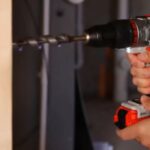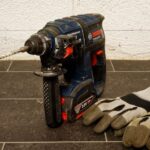Are you in need of doing some assembly for your brand new furniture and are trying to channel your inner handyman? Then you need to consider the precision required to join pieces together. Here is where having the right tools becomes mandatory as it maximizes the success of your project. This is precisely whwe’llll be sharing with you about different types of drills and when to use them.
Drills are one of the essential tools to have around at home; with the right type of drill, you can have the peace of mind that whateveD.I.Y.IY project you have in mind will go a lot smoother. That said, there is a wide variety of drills, as models differ on factors like speed, power, and size.
As you can see, with numerous drill types available in the market, choosing one may appear like a daunting task. If you want to make the most of your investment, it is key to know what each type of drill is used for.
But do not worry because we’ll be breaking down everything you need to know. Continue reading and learn about types of drills and more.
Types of Drill FAQs
What is a standard drill used forThey’rere the most fundamental type of drill, and they can be used as a part of the amplest assortment of circumstances? Standard drills are useful for both drilling gaps and driving screws. Those needing fundamental drilling and screw-driving capacity ought to consider these types of drills.
What is the best type of drill for home use?
A drill driver is by far the most popular type of drill amongst homeowners, and the reason behind that is quite simple. Drill drivers are a really versatile type of power tool that helps users perform various tasks. This includes drilling holes and driving screws into hard surfaces like wood and metal.
What are the different types of power source drills?
Type of power source drills. A corded or cordless standard drill is designed like a large pistol, with a trigger on the drill handle and a drill bit on the endThey’rere the most fundamental type of drill, and they can be used as a part of the amplest assortment of circumstances.
What is the difference between a hammer drill and a rotary hammer drill?
A Hammer drill is best suited for smaller tasks like anchoring bolts in a wall. But if you need a hammer drill for making holes in concrete foundations or for drilling thicker walls better to go for a rotary hammer instead.
Is a hammer drill better than an impact driver?
Hammer Drill
Pros:
- Hammers/ pounds the bit in addition to rotating it while drilling
- Provides a stronger action than a regular drill
- It helps you drill holes with precision
Cons:
- Considerably larger in size in heavier in weight than standard drills
Impact Driver
Pros:
- Relatively more lightweight than hammer drills
- It does not strip screws as it is specially designed to apply torque only when the bit encounters resistance
- It is best suited for light-duty fasteners
- It is a compact yet effective tool for most jobs
Cons
- Holes drilled with an impact driver might not be very smooth and clean
- The hammering action can strip screws
How are drills categorized?
Portable Drilling Machines
Also known as hand drilling machines or handheld power drills, portable drilling machines are used for small to medium-scale drilling tasks. Another amazing option is a flexible drill bit.
These drills are quite efficient as they operate at high speeds and can be used in different locations, including both indoor and outdoor spaces.
Sensitive Drilling Machines
Sensitive drilling machines are also known as bench drilling machines because they must be mounted on a plane before use. They consist of a drill head, and driving mechanism attached to a column fixed on a sturdy base.
What are the main types of drills?
- Drill drivers: A drill driver is the most popular type of drill amongst homeowners. Drill drivers are a really versatile type of power tool that helps users perform various tasks. This includes drilling holes and driving screws into hard surfaces like wood and metal.
- Impact driver: An impact driver is designed explicitly for loosening bolts and driving screws into hard surfaces. An impact driver utilizes the same rotational motion to operate a power drill. However, what sets it apart from power drills is that impact drivers combine a hammering action with the rotational movement.
- Hammer drill: A hammer drill, as the name suggests, is a powerful tool that combines the functionality of two different hand tools, a hammer, and a drill. A good hammer drill will allow you to choose between regular drilling, hammer drilling, or driving mechanically with the clutch.
- Rotary hammer drill: A good hammer drill will allow you to choose between regular drilling, hammer drilling, or driving mechanically with the clutch. Rotary drills usually have two different features. These are chipping and rotational hammering. The chipping feature provides a pounding action as you would normally get from the use of a jackhammer.
- Core drill: Core drills are a really unique type of drill. A core drill comprises a heavy-duty motor mounted on a special frame to keep it steady during operation. This exclusive tool lets you elegantly chew through concrete. Homeowners with a spark of creativity often use core drills to produce distinct artwork.
- Ground auger: A ground auger, also known as an earth auger or simply auger, is the advanced version of the antique drills that were comprised of a long and thick metal bit attached to a horizontal hardwood handle in the shape of the alphabet T.
- Screwdriver drill: A screwdriver drill refers to a motor-driven screwdriver that typically generates more torque than an average drill. A screwdriver drill refers to a motor-driven screwdriver that typically generates more torque than an average drill.
- Cordless drill: A cordless drill is any power drill that despite being driven by electricity, does not contain any cords or electric wires. It instead uses rechargeable batteries to drive the motor in the drill.
- Corded drill: Corded drills are undoubtedly the oldest form of drills that are still in use today. Corded drills usually contain a universal motor that is powered by the mains supply. Corded drills are favored over cordless drills, where heavy drilling is required.
- Benchtop drill: A benchtop drill features a thick base with a vertically standing pole to which the motor is attached. A bench drill is suitable for drilling holes through various materials, including timber, plastic, and metal.
What are the features of a drill?
- Depth stop: Fitted to the side of the drill, a depth stop can be adjusted to ensure that the hole being drilled does not exceed the desired depth. This feature can also give you a consistent depth when making multiple holes.
- Trigger-activateL.E.D.ED: A handy feature to have, especially in dark conditions, is a trigger-activateL.E.D.ED light that automatically lights up when the speed trigger is pulled.
- Auxiliary handle: An auxiliary handle improves both safety and accuracy when drilling. The extra handle can be positioned on either the left or right side of the drill and helps to increase the user’s force and control compared to just using the pistol grip handle. You can find out more about the Best Left Handed Drill Bit from our guide at this link.
- Forward and reverse function: Drill drivers have a reverse function, which allows you to turn the drill bit or screwdriver bit forwards, as well as backward.
- Keyless chuck: The chuck is at the front of the drill and holds the drill bit or screw bit. A keyless chuck means you can change bits quickly and easily without the need for additional tools.
- Torque control / variable clutch setting: The torque selection ring provides the ability to adjust the torque, the twisting force required to overcome resistance, and screw to the correct depth. The screw can be driven too deeply if too much torque is chosen.
- Gears: Drills with more than one gear let you select different speed ranges. If the drill is a single gear drill, you can control the speed with the speed control trigger. The gear control switch is usually located on the top of the drill.
- Integrated belt clip: Free your hands quickly and easily with an integrated belt clip attached to the drill.
- Speed: Measured in revolutions per minuteR.P.M.PM). Also known as load speed, this tells you how fast your drill rotates. This number is shown as the maximum speed when the drill is not loaded and drilling.
Types of Drills
BLACK+DECKER 20M.A.X.AX* POWERECONNECT Cordless Drill/Driver
The BLACK+DECKER 20M.A.X.AX* cordless drill/driver is up to the challenge of quick home repairsD.I.Y.IY projects, and more.
Use this compact, cordless drill/driver on wood, metal, and plasticIt’s’splasticIt’s’s designed with a 24-position clutch that helps keep you from stripping and overdriving screws for enhanced control over every project.
The soft-grip handle provides the comfort you need from start to finish, while the rechargeable 20M.A.X.AX* PowerConnect battery can even be used with other tools within the PowerConnect system.
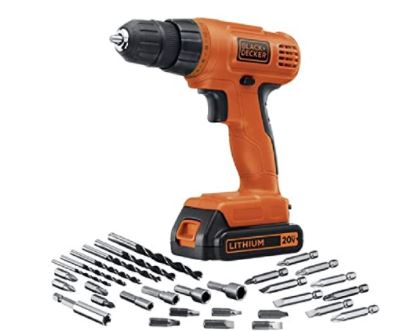
Features:
- Battery Powered
- 20 Volts
- 750 RPM
Cordless Impact Driver Kit
The Makita 18L.X.T.XT Lithium-Ion Brushless Cordless Impact Driver Kit (XDT131) delivers maximum versatility and performance, with an efficient MakitB.L.BL Brushless Motor for up to 50% longer run time, increased power and speed, and longer tool life.
The kit includes an efficient 18L.X.T.XT 3.0Ah battery which reaches a full charge in only 30 minutes, the fastest charge time in its category, for less downtime and increased productivity.
It is ideal for HVAC, electricians, plumbers, automotive mechanics, woodworkers, remodelers, and any pro contractor who requires a best-in-class cordless impact driver.
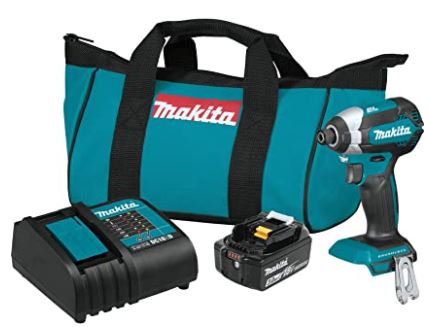
Features:
- Battery Powered
- Built-in duaL.E.D.D. lights
- Ergonomic
Skil 7.5 Amp 1/2-in Corded Hammer Drill
From tightening screws to drilling into wood, metal, and even concrete, this versatile hammer drill is the ideaD.I.Y.IY tool for a variety of home projects.
The heavy-duty 1/2-in keyed chuck accepts large-diameter bits designed for woodworking and cutting, and a side-assist handle allows for controlled and accurate drilling in any task.
This kit also includes a 100 Piece bit set for drilling into surfaces like wood, metal, plastic, and masonry.
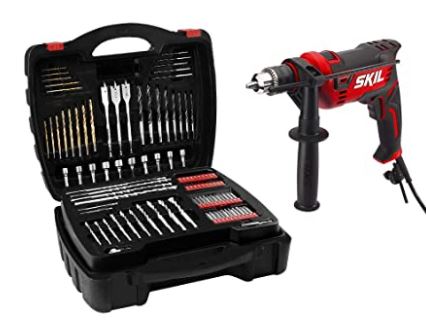
Features:
- Versatile
- Heavy-duty
- Powerful
Straight Pneumatic Drill
The fuselage side is provided with a positive and negative switch, the L block is forward rotation, and the R gear is reverse rotation.
The movement replaces the gear, has a strong torque, and the speed can be controlled slowly. Set with three speeds, maximum 1st gear, minimum 3rd gear.
Ergonomic design enables users to work for a long time without fatigue. Each time you must inject 3-5cc of pneumatic oil from the air inlet joint, press the start switch to idle for a few seconds; long-term maintenance can maintain good durability.
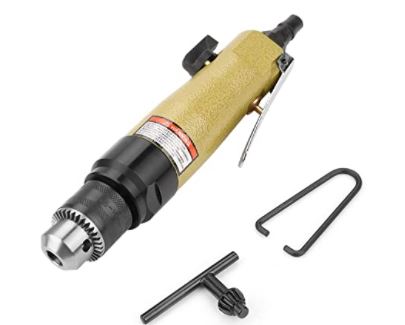
Features:
- PowerSource
- Versatile
- Ergonomic
DEWALT Electric Drill
A mechanical clutch in low gear prevents bit lock-up and provides increased gear life of the electric drill.
11 amp, DEWALT-built motor for increased power and performance in high-torque applications of the corded drill. DEWALT corded drill has two variable speed ranges (0-330 / 0-1300 rpm) to match the appropriate speed to the application.
Metal-gear housing for job site durability and increased reliability. Adjustable front handle and 2-position side handle provide maximum leverage and control.
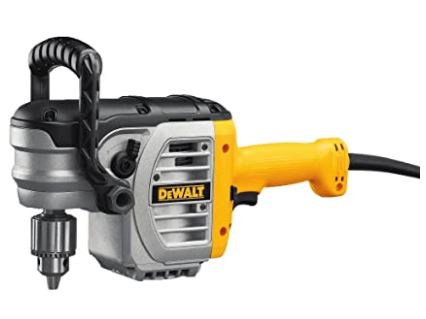
Features:
- Corded Electric
- 1300 RPM
- Mechanical clutch


